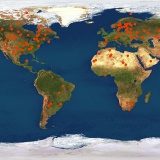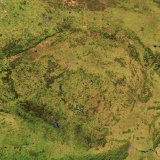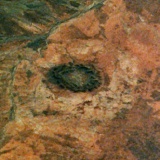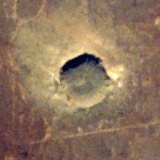 |
|||
|
Meteor
Crater in Arizona, excavated only 50,000 years ago, making it one of
Earth's younger craters.
|
|||
| CRATERS ON EARTH | |||
| Complete regeneration of the Earth's surface has obliterated traces of meteorite impacts from the inner solar system's heavy bombardment period more than 4 thousand million years ago. Many of the 200 known impact sites around the world are in the oldest, stable continental rocks, or cratons, dating back more than 500 million years. However, impacts continue at a low rate to this day. | |||
 Known meteorite impact craters worldwide. |
|||
| Major geographical features thought to have originated as meteorite impact basins include Chesapeake Bay, the Central European Depression (roughly corresponding to the extent of the Czech Republic), and part of Hudson Bay. These large, old impacts have been deformed by subsequent movements of the Earth's crust and flooded by sea level changes. | |||
 The Central European Depression, encircled by forested mountains. |
|||
| Smaller impacts include Manicouagan, Quebec (212 million years old), and Gosses Bluff, Australia. One of the most recent and best-preserved impact sites is Meteor Crater, Arizona (50,000 years old). Meteorite impact craters have a number of distinguishing features which can be detected from space: a circular shape; uplifted and overturned rock strata at the rim; for larger structures, a central uplifted peak or ring of concentric hills; for the largest structures, anomalies in the local gravity and magnetic fields. | |||
 Manicouagan, an impact crater remnant in the ancient Canadian Shield. |
 Gosses Bluff, Australia, the central uplift of a large impact crater. |
 Meteor Crater, Arizona, with raised crater rim and bright ejecta topet. |
|
 The impressions of three meteorite impacts at Aorounga, North Africa. |
|||
| About 65 million years ago, a very large body is thought to have impacted the Earth on the Yucatan Peninsula in Central America. The body, believed to have been an asteroid or a comet, may have sent enough impact debris into the atmosphere to impede photosynthesis in plant life. The timing of the impact coincides with a mass extinction of two thirds of the planet's animal species, including the dinosaurs, suggesting that large impacts can be a global catastrophe. It is precisely because a large impact might have devastating global consequences for life, that a monitoring and tracking program has been established to detect any asteroids that may be on a collision course with Earth. Many asteroids already cross Earth's orbit, and are known as Near Earth Asteroids (NEAs). | |||
| Over the last century, impacts of sizeable bodies have been reported in Tunguska, Siberia, in South America and in the Arabian Peninsula. | |||
 Variations in the gravity field off the Yucatan Peninsula, reveal a large impact structure buried under the bedrock. |
|||
| The rate of crater formation in the Solar System today is far lower than during the formation of the planets, but collisions do still occur. Many meteoroids enter the Earth's atmosphere every day, but the vast majority burn up due to friction. The few that survive the heat hit the ground, many not even forming a crater. Over 3000 meteor falls are known so far, with about 10,000 meteorite pieces recovered. | |||
| More about meteoroids | |||
|
|
|||